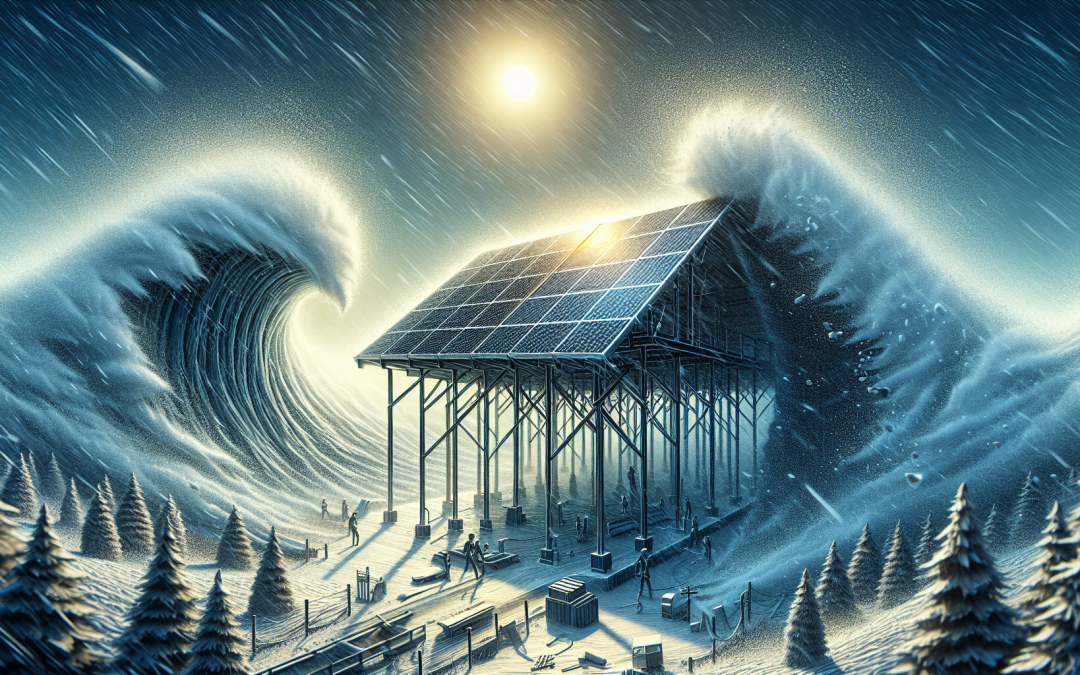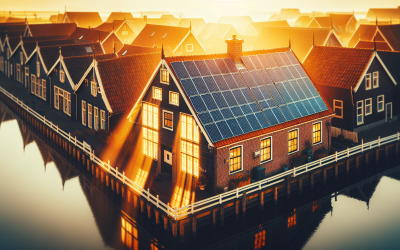When it comes to installing solar panels in areas with extreme weather conditions, you might be wondering if it’s even possible. After all, it’s easy to assume that harsh weather like hurricanes, blizzards, or scorching heat could pose a threat to the efficiency and longevity of solar panels. However, rest assured that advancements in technology have made it possible for solar panels to withstand even the harshest climates. In this article, we will explore the feasibility of installing solar panels in areas with extreme weather conditions and discuss the precautions you can take to ensure their durability and optimal performance. So, let’s shed some light on this topic and dispel any doubts you may have!
Choosing the Right Solar Panel
Understanding Extreme Weather Conditions
When considering installing solar panels in areas with extreme weather conditions, it’s essential to have an understanding of the specific weather patterns and conditions that the panels may be exposed to. Extreme weather can include strong winds, heavy snowfall, hailstorms, high and low temperatures, and exposure to salt air in coastal areas.
Impact of Extreme Weather on Solar Panels
Extreme weather conditions can have a significant impact on the performance and durability of solar panels. High winds can result in structural damage and the potential for panels to be torn off their mounts. Heavy snowfall can accumulate on the panels, reducing their efficiency and potentially causing structural damage. Hailstorms pose a risk of physical damage to the panels if they are not built to withstand such impacts. High temperatures can impact the efficiency of the panels and affect their overall performance. And exposure to salt air in coastal areas can lead to corrosion if the panels are not made from corrosion-resistant materials.
Types of Solar Panels for Extreme Weather Conditions
When it comes to choosing solar panels for areas with extreme weather conditions, it’s crucial to opt for panels specifically designed to withstand these conditions. Look for panels with features such as reinforced frames for added strength, impact-resistant coatings to protect against hail and storms, and corrosion-resistant materials for coastal areas. Additionally, panels that incorporate heat dissipation techniques can help maintain optimal performance in areas with high temperatures.
Installation Considerations
Environmental Factors
Before installing solar panels in areas with extreme weather conditions, it’s important to consider the specific environmental factors such as wind speed, snow load, and average temperatures. These factors will play a critical role in determining the appropriate mounting options and structural integrity required for the installation.
Mounting Options
In areas with high winds or frequent storms, it is crucial to choose robust mounting options that can withstand the forces exerted by extreme weather conditions. Options such as ballasted or penetrating mounts can provide the necessary stability and security needed for these areas. It’s important to consult with a professional installer who can assess the specific environmental factors and recommend the most suitable mounting option for your location.
Structural Integrity
The structural integrity of the building or structure on which the solar panels will be mounted is another crucial consideration. Ensure that the roof or ground foundation is in good condition and capable of supporting the weight and pressure of the panels, especially in areas prone to heavy snowfall or strong winds. Reinforcements may be needed to enhance the structural strength, and it’s essential to work with a professional to ensure proper installation and safety.
Maintenance and Protection
Regular Cleaning and Inspection
Regular cleaning and inspection are vital for maintaining the efficiency and longevity of solar panels, especially in areas with extreme weather conditions. Dust, debris, and even snow can accumulate on the panels, reducing their effectiveness. It’s important to clean the panels regularly, following manufacturer guidelines, to ensure optimal performance. Additionally, inspections should be conducted to identify any potential damage or wear and tear that may need to be addressed promptly.
Protection from Hail and Snow
In areas prone to hailstorms and heavy snowfall, additional protection measures may be necessary to shield the panels from damage. Some solar panels are designed with impact-resistant coatings and materials that can withstand the force of hail. Additionally, snow guards or racking systems can be installed to prevent snow accumulation and potential structural damage. It’s important to consider these protective measures during the installation process to ensure the long-term safety and performance of the panels.
Sealing and Waterproofing
Proper sealing and waterproofing of solar panels are essential in areas exposed to heavy rains or coastal environments. Moisture infiltration can lead to corrosion and potential damage to the electrical components of the panels. Ensure that the installation is properly sealed and waterproofed, and conduct regular inspections to identify any areas that may require resealing or maintenance.
Battery Storage Solutions
Importance of Battery Storage
In areas with extreme weather conditions, having a battery storage system for your solar panels can provide invaluable backup power during power outages or when the panels are not able to produce sufficient electricity. Battery storage allows you to store excess energy generated by the panels during the day and use it during times of low sunlight or high energy demand. It can also provide a reliable power source during extreme weather events when grid power may be disrupted.
Options for Battery Storage Systems
There are various options available for battery storage systems, ranging from lead-acid batteries to lithium-ion batteries. Lead-acid batteries are a more traditional and cost-effective option, while lithium-ion batteries offer higher energy density and longer lifespan. The choice of battery storage system will depend on factors such as budget, energy storage requirements, and the specific needs of your location. It’s important to consult with a professional to determine the most suitable option for your solar panel installation.
Monitoring and Control Systems
Real-time Data Monitoring
Monitoring systems are essential for keeping track of the performance and efficiency of your solar panels, particularly in areas with extreme weather conditions. Real-time data monitoring allows you to monitor the energy production of the panels, detect any issues or malfunctions promptly, and optimize their performance. Monitoring systems can provide valuable insights into the impact of extreme weather conditions on the panels and help identify any necessary maintenance or adjustments.
Automatic Shutdown Systems
Automatic shutdown systems are critical safety features that protect your solar panels during extreme weather events. These systems can detect dangerous conditions such as high winds or heavy snowfall and automatically shut down the panels to prevent any damage or unsafe operation. It’s important to ensure that your solar panel installation is equipped with an appropriate automatic shutdown system to prioritize safety and protect against potential damage.
Performance in Extreme Temperatures
Effects of High and Low Temperatures
Extreme temperatures, whether high or low, can affect the performance and efficiency of solar panels. High temperatures can cause the panels to operate less efficiently, leading to a decrease in energy production. On the other hand, low temperatures can cause a temporary decrease in performance but can also result in increased efficiency due to the cooling effect. It’s important to choose panels that are designed to withstand the temperature extremes of your location and have appropriate heat dissipation techniques.
Heat Dissipation Techniques
Solar panels designed for extreme weather conditions often incorporate heat dissipation techniques to manage the impact of high temperatures. These techniques can include using materials that have higher heat resistance, incorporating ventilation systems to allow hot air to escape, or utilizing heat sinks to dissipate excess heat. By choosing panels with reliable heat dissipation techniques, you can ensure that their performance remains optimal even in high-temperature environments.
Cold Weather Considerations
In areas with extremely low temperatures, it’s important to consider the impact of freezing temperatures on the performance and durability of solar panels. The freezing of snow or ice on the panels can reduce their efficiency and potentially cause damage. Installing panels at an angle can help promote snow shedding, and the use of anti-icing coatings or heating systems can prevent ice buildup. Additionally, choosing panels that are specifically designed for cold weather conditions can help ensure their longevity and optimal performance.
Resistance to Strong Winds
Wind Load Ratings
When installing solar panels in areas prone to strong winds, it’s essential to consider the wind load ratings of the panels and the mounting systems. Wind load ratings indicate the maximum wind speeds that the panels can withstand without experiencing significant damage. Ensure that the panels you choose have appropriate wind load ratings for the specific wind speeds of your location.
Mounting Systems for Windy Areas
In areas with strong winds, it’s crucial to choose mounting systems that can withstand the forces exerted by these extreme weather conditions. Ballasted or penetrating mounts are often recommended for windy areas as they provide stability and security against high winds. Working with a professional installer is crucial to assess the specific wind conditions and recommend the most suitable mounting system for your solar panel installation.
Impact of Snow and Ice
Snow Load Capacity
Snow load capacity refers to the ability of solar panels to withstand the weight of accumulated snow without sustaining structural damage. In areas prone to heavy snowfall, it’s important to choose panels with sufficient snow load capacity to prevent structural failure. Panels with steeper angles can promote snow shedding, reducing the weight on the panels and minimizing the risk of damage.
Snow and Ice Removal Techniques
In areas with heavy snow or ice, it may be necessary to remove the accumulated snow or ice from the solar panels to maintain their efficiency and prevent damage. Snow rakes or brushes can be used to carefully remove the snow, taking precautions to avoid scratching or damaging the panels. Heating systems or anti-icing coatings can also be considered to prevent or minimize the buildup of ice. It’s important to handle snow and ice removal with caution and consult with a professional if you’re unsure about the best techniques to use.
Protection against Hail and Storms
Impact-resistant Panels
Hailstorms and severe storms can pose a significant risk to solar panels if they are not designed to withstand the impact. Impact-resistant panels are specifically built to resist damage from hail and high winds. These panels often incorporate reinforced frames, tempered glass, or protective coatings to prevent cracks and ensure durability. When installing solar panels in areas prone to hail and storms, choosing impact-resistant panels is crucial to protecting your investment and ensuring the long-term performance of the panels.
Preventing Damage from Hail
While impact-resistant panels provide a level of protection against hail, additional measures can be taken to further prevent damage. Installing hail guards or a protective mesh above the panels can act as a physical barrier and absorb the impact of hailstones. Regular inspections after hailstorms are recommended to identify any potential damage that may need to be addressed promptly.
Corrosion and Salt Air
Corrosion-resistant Materials
In coastal areas, solar panels are exposed to the corrosive effects of salt air. It’s important to choose panels made from corrosion-resistant materials to ensure their longevity and performance. Stainless steel frames, anodized aluminum, and specialized coatings can provide protection against corrosion caused by salt air. Regular cleaning and maintenance are also essential to remove salt deposits and prevent long-term damage.
Maintenance for Coastal Areas
In coastal areas with salt air, it’s crucial to establish a regular maintenance routine for solar panels. This includes frequent inspections to identify any signs of corrosion or damage and thorough cleaning to remove salt deposits. It’s recommended to consult with local professionals familiar with the challenges of coastal installations to ensure the appropriate maintenance practices are followed.
In conclusion, installing solar panels in areas with extreme weather conditions is possible with the right considerations and precautions. Understanding the specific weather patterns and conditions, choosing panels designed to withstand these conditions, and ensuring proper installation, maintenance, and protection measures are in place are key to maximizing the performance and durability of your solar panel system. By taking these factors into account, you can confidently harness the power of solar energy in even the most challenging weather environments.









